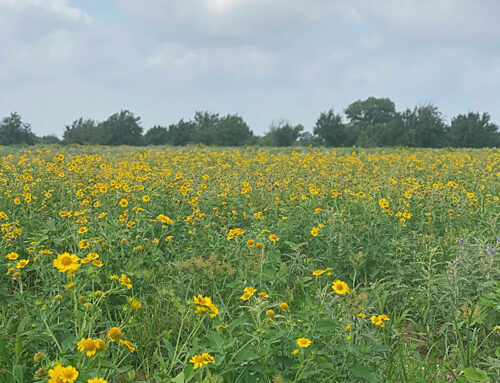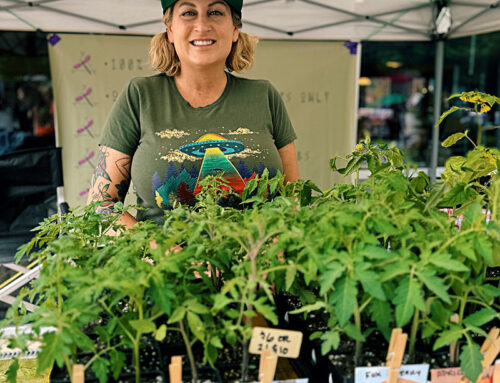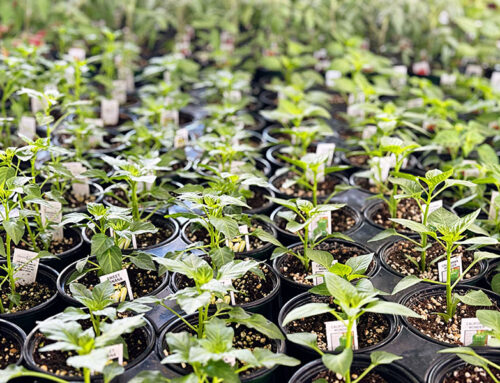By Greg Lewis
Winter is the time for hibernating … if you’re a bear or chipmunk. Even in Texas, just the thought of Dallas’ average low temperatures makes it easy for us to become couch potatoes, sit in front of the TV and eat junk food. But staying healthy all year long isn’t impossible. While it’s OK to indulge in chips and sweets every now and then, fruits and vegetables add the balance our diet needs. A visit to the Dallas Farmers Market will get you out of the house and offers a variety of veggies to satisfy your crisp and crunchy moods.
Rainbow for Health
A fruit and vegetable color chart notes how plant nutrients help your body fight disease. Red tomatoes and bell peppers reduce the risk of heart disease and cancers. Green veggies such as spinach and broccoli help fight infections. Orange and yellow produce, such as carrots and squash, are good for your eyes. Blue and purple fruits — think grapes and blueberries — improve brain function and memory. White varieties (garlic, onions, cauliflower, etc.) help control blood pressure and cholesterol.
Eat These!
Healthy produce to add to your diet include:
- Beets
- Broccoli
- Cabbage
- Carrots
- Cauliflower
- Cucumbers
- Grapefruit
- Mushrooms
- Kale
- Kohlrabi
- Oranges
- Peas
- Peppers
- spinach
- Sweet potatoes
- Tomatoes
- Turnips
You’ll find all these for sale at the Dallas Farmers Market. Types depend on the season and weather.
Dark leafy greens like chard and collard are enriched with vitamin A, K, and C. Mustard greens, escarole, and collards are rich in folate, which is important for women of childbearing age.
Potatoes are a good source of vitamins C and B6; they boost your body’s ability to fight infections. Tubers are high in fiber, too — about 4 grams for a medium-sized potato.
Indoor and Outdoor Gardening
Planting an indoor garden gives you a taste of nature during those long days of winter, and allows you to eat what you grow. You’ll need a dedicated space near a window or a table with a plant light.
If you want to try an outdoor garden in winter, you’ll need to choose vegetables that can handle the climate. Much like watering your lawn, irrigating vegetable gardens in winter should be done with care. Overwatering can drown a plant.
Healthy Winter Eating
Cookies, cakes hot chocolate, leftover Christmas candy … yeah, you’ll probably eat all that stuff (with your vegetables, of course). But foods to eat in winter include oatmeal and soup. Oatmeal has a high amount of zinc and soluble fiber. Soups — without salt, cream and beef — are excellent foods, especially when they have chicken broth and vegetables. Sushi is also a healthy choice. Rolled sushi with rice, salmon, tuna, and seaweed is a good source of vitamin D.
Portion size is important for healthy winter eating, especially when you’re prone to snacking in front of the TV. Eat meals at the dining table, turn the television off and use smaller plates.
Drink a lot of water, in addition to coffee, tea, and hot chocolate.
Garlic helps fight disease as it flavors food. Chop fresh cloves and let the pieces stand for 15 minutes before adding them to your cooking pan.
Tongue Ticklers
Tart and juicy pomegranates have a high number of antioxidants that fight the “bad” LDL cholesterol that our bodies produce. Drink a cup of pomegranate juice each day or chew on the fruity kernels.
Citrus fruits are an excellent source of vitamin C. Oranges, grapefruits, limes, and lemons are rich in flavonoids that boost HDL — the “good” cholesterol.
Late fall into winter, we see a lot of holiday-related foods, and who can resist them! Halloween candy, Thanksgiving pies, Christmas cookies, Valentine’s Day sweets — it’s an endless line of sugar. Balance out your diet with fresh fruits, vegetables, and grains to stay healthy all season long.
~ Greg Lewis is a fitness trainer and health food addict. He enjoys growing his own organic fruits and vegetables and cooking them for friends and family.








